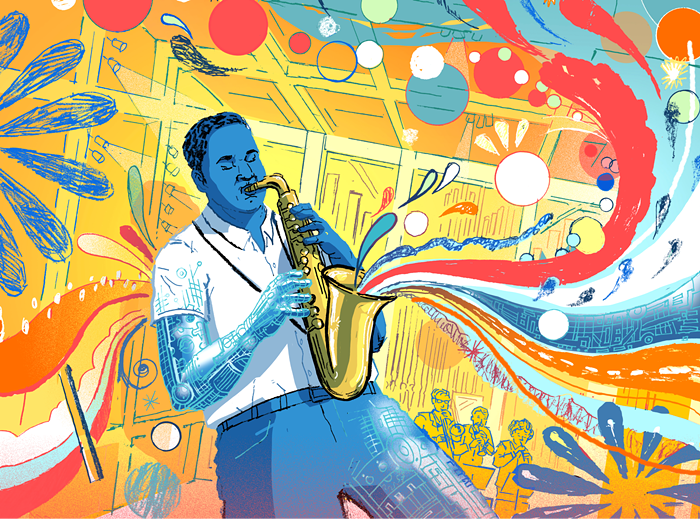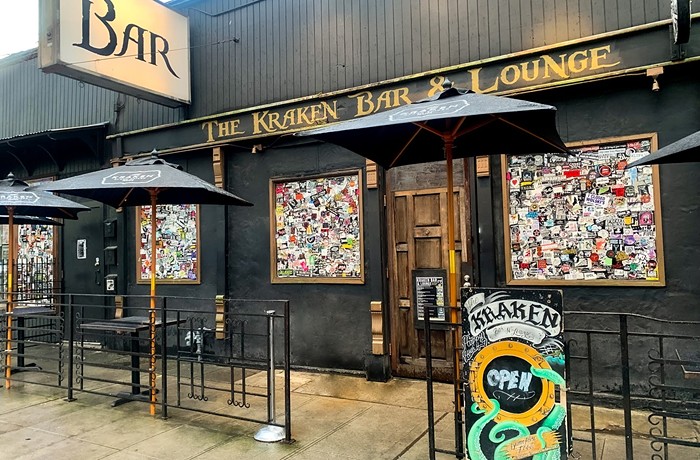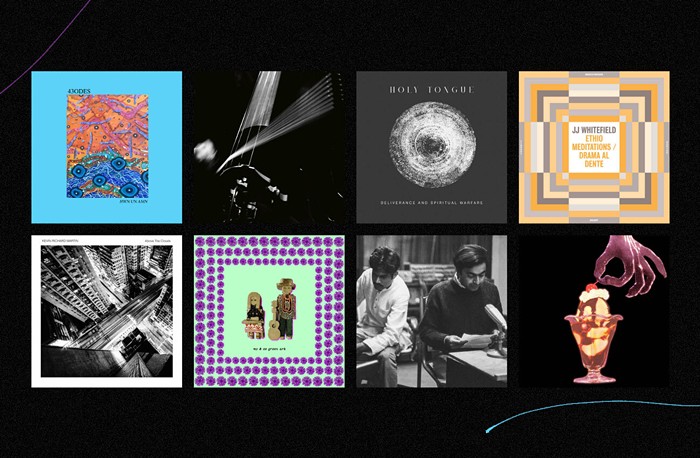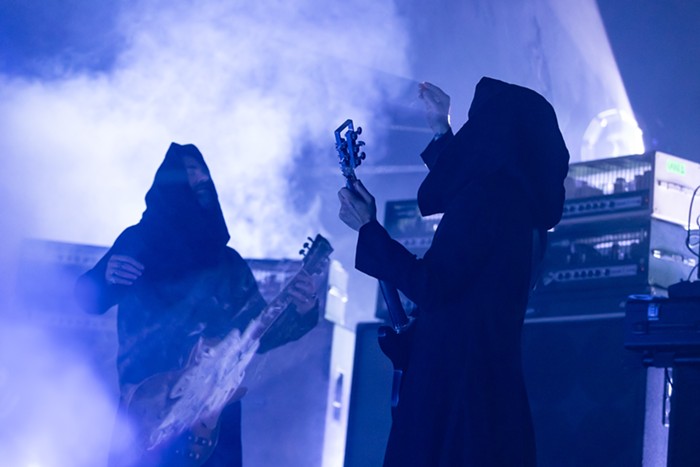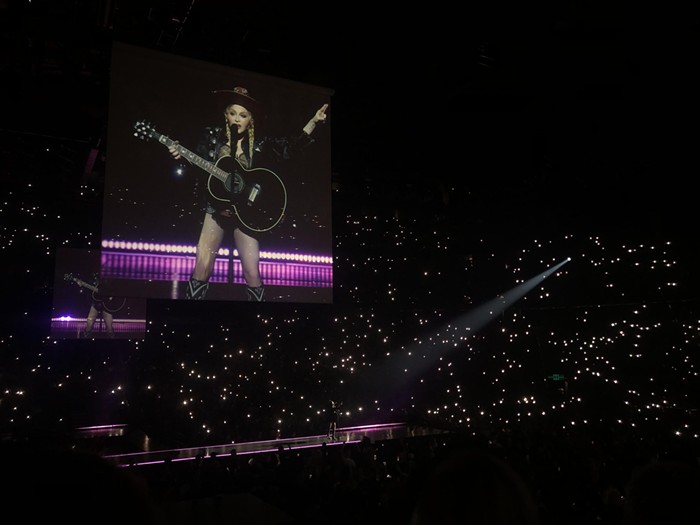
The Black Friday edition of Record Store Day is happening November 23, and one novelty that will be occupying shelf/bin space is the hologram vinyl release of the Ratchets' 7-inch single, "Gotta Be Cool"/ "Rock and Roll" (a Velvet Underground cover), via Emeryville, California company Pirates Press. Using the same technology as that found on some world currencies, Pirates Press created a hologram on one side of the vinyl whose grooves are playable under the image [see the video below for a demonstration]. The Czech company GZ Media presses these unusual records; IQ Structures generates the holograms. They look very cool while they're spinning; if the music's good, well, that's a bonus.
The advent of hologram vinyl represents an uptick in the arms race for novelty artifacts in the music industry, which is struggling in the age of streaming services. According to Pirates Press owner and marketing wiz Eric "Skippy" Mueller, one way for a record company to appeal to consumers during this difficult period is to make their releases objets d'art just as suitable for hanging on walls as for spinning on turntables. His label traditionally has favored multi-colored wax, picture discs, and flexi-discs, so manufacturing hologram vinyl has been a natural progression for the analog-friendly company. He says that orders for more such releases are pouring in.
Reached by phone, Mueller speaks with polished enthusiasm about his products—and an almost evangelical zeal. "Our emphasis is always promoting things that will draw people toward a physical product, as opposed to a streaming or digital product without a tangible end. The way we see it, though, streaming and digital and the uses of music online are not going anywhere, and they're only getting more complex, but the physical component that can tie into it is something that a lot of people still hold really highly in their lives as like a component of their identity."
Americans' propensity to collect things is rooted in both vanity and nostalgia, Mueller says. "The same way that people collect baseball cards, or cars, or art, people collect music. And vinyl is arguably the best way to do that. The format is the largest as far as the artwork is concerned. People who collect LPs really enjoy reading lyrics and things like that, so the physical component is massive. In today's world, there's a lot of people putting out records, so it's really hard to stand above."
Pirates Press prides itself on listening to its customers, and they have been asking it, Mueller says, "to make things that maybe once were made in the '70s and nobody's seen one since, and things like that, or taking an old technology and revitalizing it and making things better, as we did with the flexies, where they hadn't been made for almost 20 years. And the product that we reintroduced to the market took advantage of lots of technological advances that took place between when those old machines were made and the machines in the process that we used to make ours."
Mueller notes that the sound quality and printing options for hologram vinyl have improved, making the results more attractive and cost-effective than they've ever been. "There's only seven or so that were ever made, and the technology is very much proprietary and elusive. And in some ways, it came about somewhat organically between a design firm in Prague [IQ Structures] and our vinyl team in the Czech Republic [GZ] who physically made the records.
"What we're now doing is testing all the limitations with regards to how it may affect the sound, because more or less, you have to cut the grooves into the hologram, and you can only remove a certain amount of the surface area, or carve into a certain amount of the surface area before the image gets distorted beyond the point where it still maintains its cool factor. So, it's a lot of math and a lot of trial and error." Currently, the technology can only be applied to 7-inches, but the goal is to get it on 12-inches for an even more spectacular effect.
Pirates Press's business model stresses high-end packaging, like box sets, commemorative editions of classic records embellished with books or additional ephemera. Often, Mueller admits, people buy these deluxe items but don't even listen to them. They'll simply stream it on Spotify or on Bandcamp, or wherever. "It's a collectors market, to some extent."
While acknowledging the existence of vinyl purists, Mueller observes that it's uncommon now for people to listen exclusively to records. "I think most people at least split their music-listening time into multiple formats, just out of sheer convenience. One of the things that's really driven Pirates Press since we started in 2004 was being one of the first companies that included digital downloads for our customers, working with Drop Cards," who marketed a credit-card-style download before dominated the business.
But what about the sound quality of hologram etched piece of vinyl? And will people be able to tell a difference between it and regular vinyl? "The hologram itself doesn't impact the grooves' quality. What is impacted is the fact that the grooves have to be set up at certain angles, at certain amplitudes, and with different lenses, and different dimensions, so that once it's cut, the image is still visible in the way that you want it. If you cut a record with the most optimal settings possible for the best-sounding record, and you cut that record onto a hologram, the hologram itself wouldn't look good. So you have to alter the settings for the cutting to be able to allow the hologram to look right."
So, let's say your band wants to do a hologram-vinyl release; you'd better be prepared to shell out more than your typical 45. It costs $7,000 to set up the machinery and then about a quarter per unit. "A lot of [the cost derives from] design work that's proprietary to our studio in Prague," Mueller says, "and the elements of the different types of holographic effects that can be done, and taking what amounts to a flat piece of artwork, and creating multiple different types of effects that will work differently depending on which way the light's angling and things like that."
Mueller says that orders for hologram vinyl will most likely be made by more popular bands rehabilitating old hits or for new songs that will eventually become collector's items. At the moment, about a dozen different artists have hologram-vinyl releases in the pipeline with Pirates Press.
Is Pirates Press counting on hologram vinyl to be a huge success, or is Mueller cautiously optimistic about its prospects of catching on? "We make hundreds of thousands of picture discs every year, and the vast majority of them are not being listened to; they're being put on a wall. And these holograms are way cooler than a picture disc and serve the same purpose. So, I would be shocked if people don't grab hold of them and start using them in the same types of situations that they're currently using picture discs for.
"And in some cases, they are actually cheaper than picture discs when you get up into higher quantities. And we're just starting with all the cool effects that can actually be done with these. We're really looking forward to another one that we're working on right now that is gonna end up having photographic hologram effects."

